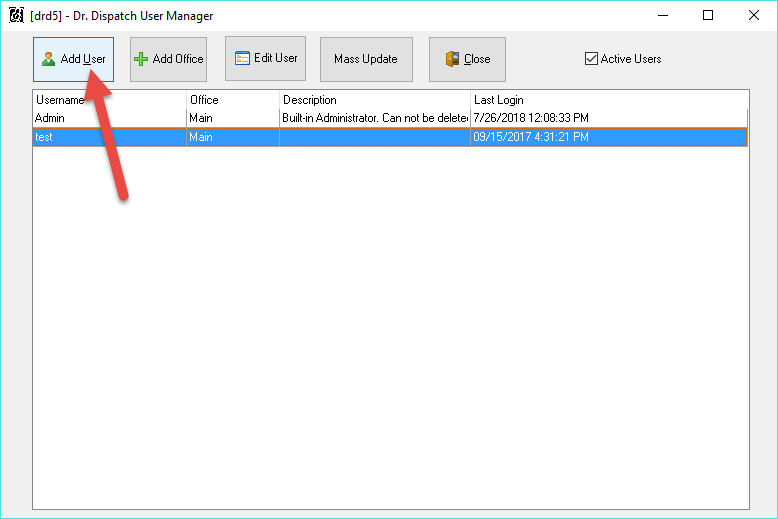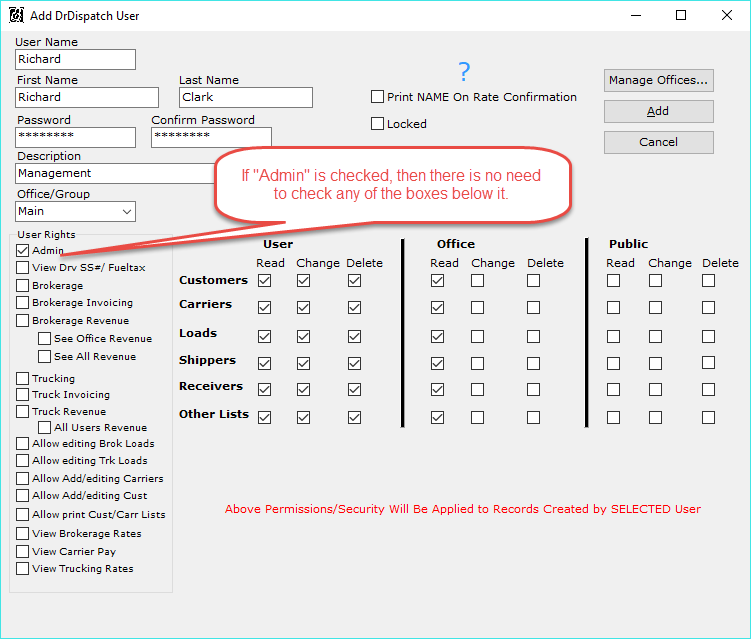In this scenario, we will set up an office of three users.
- We will make the user/employee/dispatcher James's loads private, all the carriers James creates in Dr Dispatch public, and all the customers James makes private.
- We will also make the user/employee/accountant Pam have access to only certain parts of the program.
- Finally, the manager/administrator Richard will have full access to the program.
Before starting, make sure that Multi-User Security is enabled.
- Review this this article to enable multi-user security.
Note: Enabling security after using Dr Dispatch to enter in loads, customers, carriers, shippers, and/or receivers beforehand will have ownership of all previously entered data assigned to the built in Admin user.

- Next, open the Password Manager by opening the System menu and selecting Password Manager.

- Here, you can manage your User and Office accounts.
- Click on "Add User" to get started.

- To change what loads, customers, carriers, shippers and/or receivers that others can and cannot access, we modify the permissions for each record (i.e. load, customer, carrier, shipper, or receiver) that a User creates.
- Dr Dispatch has three levels of permissions:
- User:The user that created the load, customer, carrier, shipper, or receiver.
- This will be James, Pam, or Richard in our example scenario.
- Office:The user's office that created the load, customer, carrier, shipper, or receiver.
- This will always be Main in our scenario since we are only using a single office.
- Public:Anybody who is not either the record's owner or in the record's office.
- Not used in our case, as we are using only one office in this scenario
- User:The user that created the load, customer, carrier, shipper, or receiver.
- Each level of permissions above has options of Read, Change, and Delete records
- (which are loads, customers, carriers, shippers, and receivers).
Adding James the Dispatcher:
Let's add our dispatcher, James, and configure his permissions to allow him into Trucking and Brokerage, keep him out of Invoicing, and make it to where he can only see revenue made on his own loads/figures. James can edit loads and print customer/carrier lists.

- In this example, James can Read (or see), Change (or modify/edit) and Delete his own records
- This includes his own customers, carriers, loads, shippers, and receivers.
- James's office (Main) can Read James' , carriers, shippers, and receivers.
- However, loads and customers will only be visible to James and Administrators.
- As we specified at the beginning, all Carriers that James creates will also be visible to Public (users in other offices.)
Adding Pam the Accountant:
Pam's settings are similar to James's settings above. We want Pam to have access to invoicing but not revenue. Revenue will be for management only in this example.

Adding Richard, a Boss/Management User:
The Admin check box gives users full access to the program, and thus there is no reason to check anything below the box
- Admins can get into revenue, invoicing, and anywhere else in the program.
- Admin has full access regardless of private permissions on users (in our example, Richard can see everything that James or Pam creates).
- We still have to set up our object creation permissions to the right, because Richard the Admin might create loads, customers, carriers, and other records that will still need to have those permissions assigned to them.

Managing the Data:
At this point we can log in to Dr Dispatch and see that not much has changed (yet). Built-in 'Admin' user owns all of our data in a very public way, by default. Unfortunately, there is no viable way to have Dr Dispatch selectively update your data between the users we just added. There is no good way to know who owns what without human intervention. We can re-assign records to their customers and divvy them up by hand, though.To verify this, we can log in as the user 'James' and still see all customers and loads. I can right-click with my mouse on a record to see how it's permissions are built.
Below I am right-clicking and selecting Security from the menu to view the properties for "King Publishing".

Let's zoom in on the permissions

We can tell from the top that the built in 'Admin' user owns this record. The Main office fills the office/group slot and we have NO public permissions. That means, as the user 'James', I am not the owner (Admin user is the owner) so the owner permissions in the User row do not apply
- James IS in the office "Main", so Office category permissions DO apply.
Note that while the main office has change/modify permissions, James can NOT revoke anything from the owner. This is by design.
Only an administrator or the owner can change or re-assign User permissions.
What happens if James creates a new customer?

Just as we specified, James owns this new customer with full control. Nobody else, including James's colleagues in the 'Main' office, can even see the new customer (except for Admin users).
What about carriers?
We specified at the beginning of this document that User's carriers should be public.
James enters a new carrier and checks the security to see:

Just as we specified!
Now, if we log in as 'Pam', she can not seen James's new customer but CAN see his carrier. I also entered a new load as James, and Pam could also not find Jim's pro 1033.
Everything is working just as we specified except for one critical piece. Data existing before we enabled security is still public!
This is a catch-22 situation. Dr Dispatch must apply security to ALL records or nobody can see them yet, but Dr Dispatch can't intelligently decide which user(s) should own what. The only sensible way to do this is to assign everything to the 'Admin' user itself so the Admin can distribute the records to whoever they belong to. Dr Dispatch leaves these Public visible (but not Public Change/Delete) so that users can, in a pinch, work with their data while somebody straightens it out with the 'Admin' user.
- You can use the Security Manager to modify a user's data all at once.
- We can, for example, take everything owned by 'Admin' to private in order to match our specs at the top of this document.

Clicking OK in the above example will take any record (except carriers, we left that unchecked on purpose) owned by Admin and make these records only readable and changeable by Admin.
Revenue:
Revenue is the section of Dr Dispatch that displays company performance data.
James is set for limited revenue access. James can pull revenue reports for his loads, customers, carriers, etc. but he can NOT see company wide revenue or other employee's numbers. Optionally, we can deny James, or any other employee, Revenue access completely by removing the Revenue check mark(s) from User Manager
Invoicing:
In this example, James can not enter any Invoicing section. Pam's user is setup with no Revenue access but does have Invoicing access, since Pam does the billing and doesn't really need Revenue section access. Users like Pam with Invoicing access have total control within the Invoice section in Dr Dispatch. When printing invoices the Main Office address information is used unless otherwise specified.
Multi-office:
Multi-office setups work the same as the above scenario. The only differences being that Public permissions will come into play and that users will be divided/assigned between each office name/code.
Were you looking for Setting Up Individual Users: Quick Reference or the Security and General Preferences screen in Settings?
